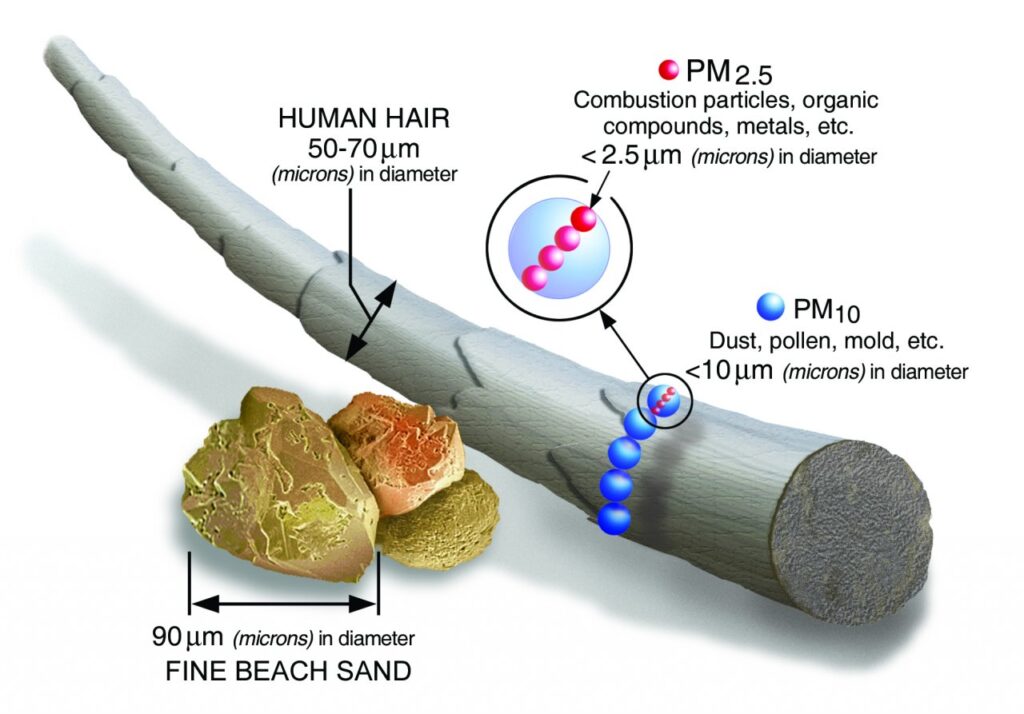At the time of this writing, there are 3 active wildfires in Southern California: the Line Fire in San Bernardino County, the Bridge Fire near Los Angeles, and the Airport Fire in Orange and Riverside Counties. Depending on where you live, you might be able to smell the burning wood, or see the sky darken from the smoke plumes.
The first concern should be whether the fire could actually overrun your home or work. If you live in an evacuation zone, getting your family and important documents to a safe place is the priority. An impressive all in one website is Cal Fire’s, which provides information based on your ZIP Code, including current weather conditions, nearby fires, and a checklist for action. fire.ca.gov gives additional information on all the wildfire incidents in the state, with clickable links showing updates, maps, and information about evacuation areas and local resources including temporary evacuation sites, animal shelters, and road closures.
Next: microparticles
The smoke from these fires carries particulate matter that can penetrate deep into the lungs and bloodstream, causing both short-term and long-term health issues.
When discussing particulate matter (PM) from wildfires, two main categories are of particular concern: PM10 and PM2.5 (image courtesy of the EPA):

- PM10: Particles with a diameter of 10 micrometers or smaller that can penetrate deep into the lungs
- PM2.5: Even more concerning particles smaller than 2.5 micrometers, which can enter the bloodstream and cause systemic health problems
I’ve seen the effect of these particles on my patients with asthma and emphysema; and according to the World Health Organization, about 7 million people die annually due to air pollution-related diseases — the second-highest risk factor for noncommunicable diseases including heart attack, stroke, respiratory failure, and cancer. “The burden of disease attributable to air pollution is now estimated to be on a par with other major global health risks, such as unhealthy diets and tobacco smoking.” Wildfire particulate matter is even worse, causing 3 to 4 times greater oxidative stress and inflammation than other ambient PM2.5 sources, with an up to 10-fold increase in hospital admissions.
You can play with the Weather app on your smartphone, which can tell you the wind direction relative to a nearby wildfire, and the air quality using the Air Quality Index scale (AQI): less than 50 is bueno. This website explains the index, and gives up-to-date reporting based on your city or zip code.
Filters that work
While it’s impossible to avoid exposure to particulate matter during wildfires, if you have to stay put, you can reduce your exposure pretty easily:
N95/KF94 Masks
N95 masks are designed to filter out at least 95% of airborne particles. When properly fitted, they can significantly reduce your exposure to harmful particulates. Cloth masks or surgical masks are not effective against fine particulate matter. If your airways are super sensitive, you may want to splurge for the real double-strap masks with a tight fit, or the ones from hardware stores designed for contractors.
HEPA Air Filters
High-Efficiency Particulate Air (HEPA) filters can remove up to 99.97% of airborne particles that are 0.3 microns in diameter. Using portable HEPA air purifiers in your home can greatly improve indoor air quality during wildfire events.
Medications and supplements
It goes without saying that you should refill your asthma, emphysema, or allergy prescriptions if you can feel your breathing problems acting up, and let whomever your healthcare provider is know.
Glutathione is a supplement available in pill, liquid, or even an inhaled form, that may reduce inflammatory cytokines in lung tissue and support immune system function. It was an option early in the pandemic when we didn’t have many options; I have personally supplemented with the liposomal form for enhanced bioavailability with good success.
As always, discuss your specific situation with your doctor.

Leave a Reply